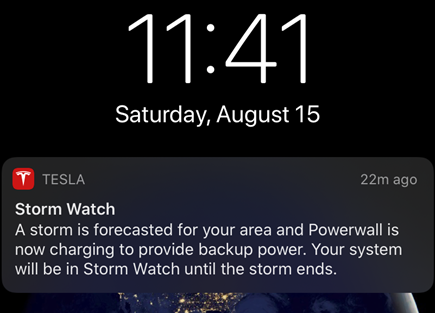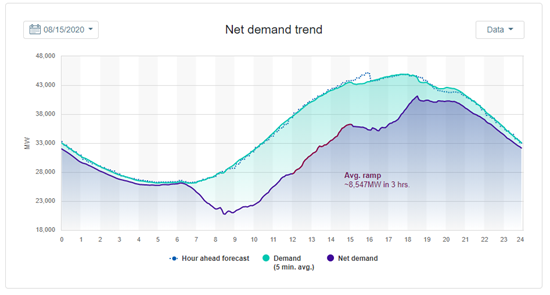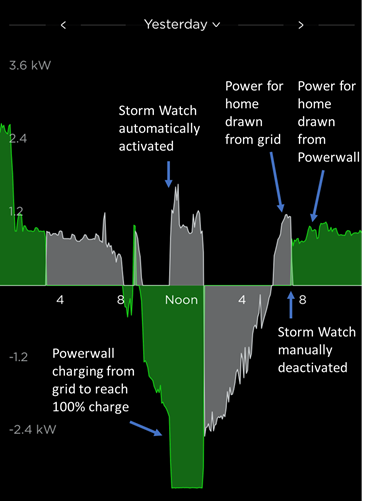1/The rotating power outages from the @California_ISO Stage 3 emergencies on Friday and Saturday are bad news!
I wanted to share a strange thing that happened with my newly installed Tesla Powerwall that makes me wonder if @Tesla is inadvertently making the problem WORSE!
I wanted to share a strange thing that happened with my newly installed Tesla Powerwall that makes me wonder if @Tesla is inadvertently making the problem WORSE!
2/ To be clear, this is not meant as a critique of @Tesla. I’ve had only positive experiences with the company and the Powerwall so far. I just thought it was important to point out a possible unintended consequence of how some battery systems (not just Teslas) may be operating.
3/On Friday, my Powerwall was operating in "Self Power" mode. During the peak hours from 3-10pm, my Powerwall powered my home and I drew no power from the grid. I was proud that I was doing my part to reduce strain on the system!
5/Saturday was different. Grid conditions were also very bad, but my Powerwall had automatically switched to “Storm Watch” mode that morning. The idea of this mode is to keep close to 100% charge to ensure that I have full backup power in case there is a blackout.
6/HOWEVER, this meant that instead of using my battery to reduce demand on the grid, I was actually drawing from the grid around 6-7pm -- the worst possible time! (see CAISO demand curve from Saturday).
7/I get that this may be what many customers want (i.e. a full battery if the power goes out). However, it is also totally counter to the needs of the system and could even increase the chances of a blackout.
8/Luckily I had logged into my Tesla app to see what was happening, caught the problem, and immediately switched off “Storm Watch” mode. The Powerwall resumed powering my home as it did the day before. I felt relieved I was not worsening the problem.
9/However, I’m sure most Powerwall owners would not know or think to do this and honestly they would have no self-interested reason to do so. There should be a way to make some simple changes that would better encourage this.
10/In closing, a couple of thoughts/questions:
First: This seems like a ripe opportunity for Demand Response. What if instead of automatically switching to Storm Watch, the alert had said: “Do you want to stay on Storm Watch? Or do you want $100 to switch to Self-Power mode?”
First: This seems like a ripe opportunity for Demand Response. What if instead of automatically switching to Storm Watch, the alert had said: “Do you want to stay on Storm Watch? Or do you want $100 to switch to Self-Power mode?”
11/
Second: I am left wondering what triggered the Storm Watch to activate in the first place. Was it in anticipation of possible rotating outages (i.e. Stage 3 emergency)? Or was it the unusual thunderstorms we experienced overnight in the Bay Area?
Second: I am left wondering what triggered the Storm Watch to activate in the first place. Was it in anticipation of possible rotating outages (i.e. Stage 3 emergency)? Or was it the unusual thunderstorms we experienced overnight in the Bay Area?
12/ If it was thunderstorms, perhaps this was just a strange coincidence of bad weather occurring simultaneously with very hot temperatures in SoCal driving up demand on the grid.
13/ If it was the possible rotating outages, then “Storm Watch” (as it currently functions) seems like a potential problem for distributed storage resources if they want to be seen as a key part of a reliable future grid.
14/
@California_ISO just issued a Flex Alert for the next four days. Are there other @Tesla Powerwalls currently in Storm Watch mode that could be helping out to meet the peak?
http://www.caiso.com/Documents/Flex-Alert-Issued-Next-Four-Days-Calling-Statewide-Conservation.pdf">https://www.caiso.com/Documents...
@California_ISO just issued a Flex Alert for the next four days. Are there other @Tesla Powerwalls currently in Storm Watch mode that could be helping out to meet the peak?
http://www.caiso.com/Documents/Flex-Alert-Issued-Next-Four-Days-Calling-Statewide-Conservation.pdf">https://www.caiso.com/Documents...
15/15
I& #39;m optimistic about the long term prospects for distributed resources like my Powerwall (and in near future, EVs!) to help with grid reliability, but it looks like we may still have some work to do to get there!
I& #39;m optimistic about the long term prospects for distributed resources like my Powerwall (and in near future, EVs!) to help with grid reliability, but it looks like we may still have some work to do to get there!

 Read on Twitter
Read on Twitter





